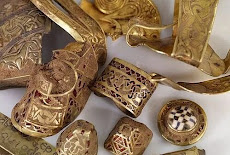 |
The effects of the antiquities market that anyone can see in the
Western Cemetery at Dura Europas, Syria (Google Earth)
|
A Canadian artefact collector has a question:
furk_61 [Jun 8/9 #98600/
#98603]
Ancient Roman Vases and Artifacts
I was wondering if anyone here knows good dealers to get ancient roman vases, bowls, other pottery, and rings for cheap?//
Maybe a small vase in good condition for like 80 USD. I live in Ontario. Also sorry if the 80 USD does not make sense, I am not familiar with Roman artifacts.
This elicited a response (note the issue of "rings" was avoided):
kyrikmk Jun 9 #98605
You will be lucky to find a Roman vase for $80 more like $200/500 depending on size and condition. If you're on a small budget look at oil lamps or even coins to start with. V coins have many dealers based in the US. Look at their website for an idea.
The collector elucidated:
furk_61Jun 9 #98606
Thanks for the suggestions kyri. I am actually a mainly coin collector, but if oil lamps can be bought under a small budget, that sounds good!
'Sounds good'? What the collectors fail to mention is that most countries that produce real dug-up Roman artefacts have laws that prevent the transfer of ownership to private hands or the market, so buyers need to look out for items with paperwork to show that the objects they want to purchase have come onto the market by verifiably legal means, but also (since laws exist to control that too) export by legal channels, with the paperwork. Most Roman pots sold online have no mention of the existence of that paperwork. And collectors and other dealers don't ask for it.
The second point is that ripping these items out of the soil involves the destruction of archaeological context. The digging for artefacts, with and without a metal detector, damages and destroys sites, not only by disrupting stratigraphy, but above all by selectively, but also randomly removing archaeological evidence from them, rendering what is left useless. Unique sources of future archaeological information are reduced to mere hole-ridden vestiges of their former self, not a very valuable asset to replace the ability of a few selfish individuals to put a few hundred dollars in their pockets.
The third point that leads on from this is where do the complete pottery and glass vessels quite frequently on sale come from? Most Roman sites all over the Mediterranean world, the MENA region and western Europe produce lots of scattered potsherds that can rarely be joined into a whole vessel. You get complete pots from wells and cesspits, shipwrecks but above all grave and tomb furniture. Does the Roman pot on offer come from grave-robbing (or plundering a protected historical wreck)? Entire cemeteries are emptied by artefact hunters for the grave goods, the human remains are thrown about and left lying on the surface. All so some foreign dealer can earn their 200/500 dollars, no questions asked (see Daubney 2018).
There is the issue of telling real from fake. There is a seller in the UK that has job lots of Roman pots that ostensibly come from a collection in an Asian country that has no right to be producing such vessels, looking at the fabric and form of the vessels, with the eye of an archaeologist who's processed more Roman pottery than I'd care to admit to, I think they are all fake.
This brings us to the rings, like other forms of personal adornment, they are lost as loose finds on and around settlements, in the long grass at the edge of the fields while tending a baby or making love. They can then be found by metal detectorists who'll be searching such areas for hours to get a handful. Or the artefact hunter can target a cemetery, and take the finger rings that were buried with the deceased as a token of love.
Fortunately, it seems to me that there are whole modern factories (Bulgaria and now the Balkans it seems) that are producing large numbers of probable- and improbable-looking fingerrings for the market, ready patinated (you don't want to know) and distressed. Many of them are bought by people that intend to actually wear them ("again") to experience the frisson of wearing something from a dead person's fingers. "OOoooo, cool", eh?
Of course these are the sort of things you'll find collectors NOT talking about among themselves. I guess the dealers would not like it if people started to think aboiut "responsible collectiong" and started to ask such questions.
References
Adam Daubney (2018) Grave Finds: Mortuary-Derived Antiquities from England and Wales, Public Archaeology, 17:4, 156-175, [DOI: 10.1080/14655187.2019.1635408].




















